Come Together Guitar Lesson (Beatles)
Over the years countless students have come to me and said, “I’m not really a blues player”, but then in the same breath tell me about how they are working on tunes like “Come Together” or “Johnny B. Goode”. And that’s what they really want to play… Not the blues…
Well, here’s the thing…
You can’t play any popular music from the past 120 years without playing the blues.
If you play guitar, you have to learn the blues. And even if you think you don’t, you’ll still be learning it inadvertently through other songs you want to play.
So today I want to show you how “Come Together” is deeply rooted in blues.
When you can identify patterns, like what I’m going to share with you in this lesson, you can learn songs WAY faster.
It gets EASIER, and songs make more sense.
Plus after sitting in at countless jam nights, and with various bands I can say with certainty that this song is worthwhile to know if you want to jam with others.
Alright well with that said, let’s dive in!
Who wrote Come Together?
The song "Come Together" was written by John Lennon, one of the members of the legendary British rock band The Beatles. It was released as the opening track on The Beatles' 1969 album titled Abbey Road.
"Come Together" is one of The Beatles' most famous and enduring songs, known for its distinctive groove and iconic lyrics.
What key is Come Together in?
“Come Together” is originally done in the key of D. However, the D chord is a D7#9 which contains both a major third and a minor third. It’s a blues style.
John Lennon sings very heavily the bent blue 3rd between (F and F#) against the D chord creating a bluesy flavor in the verse. Then in the chorus, the melody clearly sings the F#. So the answer to the question of whether it is D minor or D major would be “Yes”... It’s D blues.
However, if I was onstage and the band asked what key to play it in, I would just say D.
Come Together Guitar Chords
To play “Come Together” you will need to know these 5 chords, D5, A5, G5
B5, and B5/A.
These chords essentially make up the I, V, IV, and vi chords in the key of D.
All of these chords (except for the last one) can be played with the same basic ‘shape’ just in a different place on the neck.
For D5 we’ll play this:
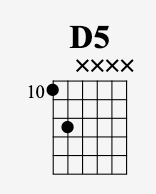
A5 is played the same way but relocated to the 5th position like this:
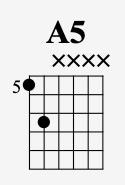
For G5, just move down again another 2 frets like this:
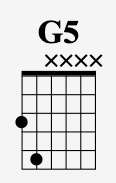
Then for B5, we’ll shift that same shape to now have a root on the 5th string. The previous chords’ roots were all on the 6th string. B5 moves to the 5th string and is played like this:
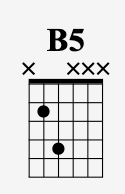
Finally, for B5/A, we’ll take the B5 and just lift off the index finger to play the open A string like this:
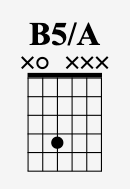
Can you see how all of these shapes use the same 2-note basic structure (except for the B5/A)?
This shape is often called a power chord and will be the heart of the blues rhythm pattern we create when we play the verse groove.
But next, let’s talk about…
Intro riff
The intro riff starts out with two eighth note-down strums on a D5 power chord. Then we’ll play a hammer-on from the 10th fret on the 5th string to the 12th fret. Then finish it off with a double-stop at the 10th fret on the 3rd and 4th strings like this:
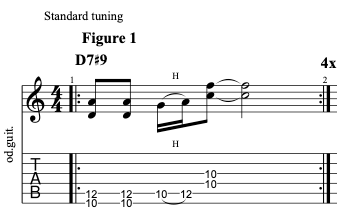
The guitar just lets the notes ring out while the drums play a fill. This riff is repeated 4 times.
The underlying chord here is the D7#9 chord which I mentioned above. (The Jimi Hendrix Chord) This shape isn’t played in the guitar part, but here is a great voicing of it just to keep in your back pocket.

Verse
After the intro riff is repeated 4 times. The song settles into the verse groove. Here is where we are going to borrow from our typical blues shuffle rhythm. I call this a “root-fith” to “root-sixth” pattern. It’s used in millions of songs to create rhythm patterns that reminisce the blues but don’t necessarily follow a common 12-bar structure.
This blues rhythm guitar part can be played over the I chord (D) like this:
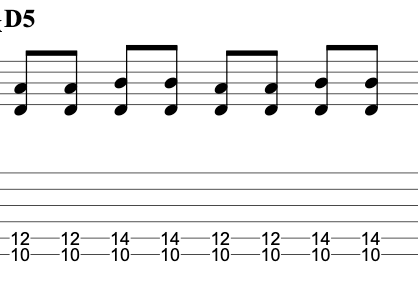
Then simply move the same pattern down to the 5th position and you’ll have the rhythm part for the V chord (A) like this:
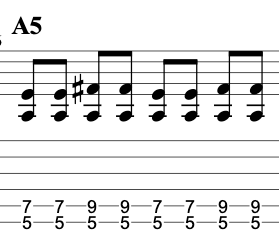
(Tip: Although not noted I recommend playing these blues rhythm patterns pal muted)
For the IV chord (G) in the Verse there is a break. So here I usually just hit the downbeat and then rest. However, some players let it ring out (which will work as well). On the Beatles record the guitar breaks while the bass rings out.
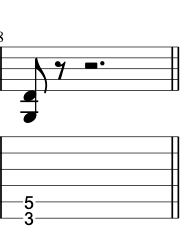
Chorus
Finally, we get to the Chorus and this section is just 2 bars long. Here I use a driving eighth-note rhythm on all down strums. I play 3 beats of B5, then 1 beat of B5/A. Then in the second bar, I play G5 to A like this:
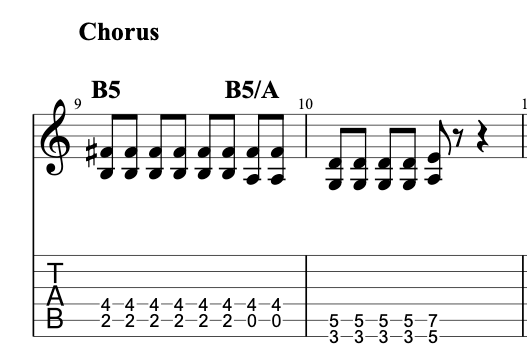
The driving eighth notes sound great played as all down strums with the strum hand. This is often my go-to approach when I want to sound more aggressive and in a rock guitar style.
Come Together Guitar Solo Lesson
The guitar solo in "Come Together" isn't your typical rock fireworks display. It's a tightly coiled burst of bluesy emotion, a short but sweet cry that elevates the song.
The solo leans heavily on the D blues scale.
One thing that really grabs you is the way he bends the strings.
Conclusion:
"Come Together" by The Beatles is not just another iconic rock song; it's a prime example of how the blues have influenced popular music for over a century. Through this post and lesson, we've discovered how seemingly unrelated genres like rock and blues are deeply interconnected, making it essential for guitarists to embrace the blues.
By dissecting the song's key, chords, and distinct elements, we've unveiled the bluesy essence that is at the foundation of "Come Together."
Understanding these shuffle patterns and techniques not only makes learning this classic track easier but also equips us to explore our own music and express what we feel on the guitar.
Aspiring guitarists, whether blues enthusiasts or not, can draw inspiration from the blues' timeless influence on countless songs, just like "Come Together." So, as you continue on your musical journey, remember that beneath almost every melody and chord progression, the blues are there, waiting to be explored and incorporated into your own unique style.
So, grab your guitar, and have fun jamming "Come Together". And for another great Beatles’ style blues guitar lesson check out Yer Blues next!
Like this blog post? Get Jon’s best guitar lessons straight to your inbox.
